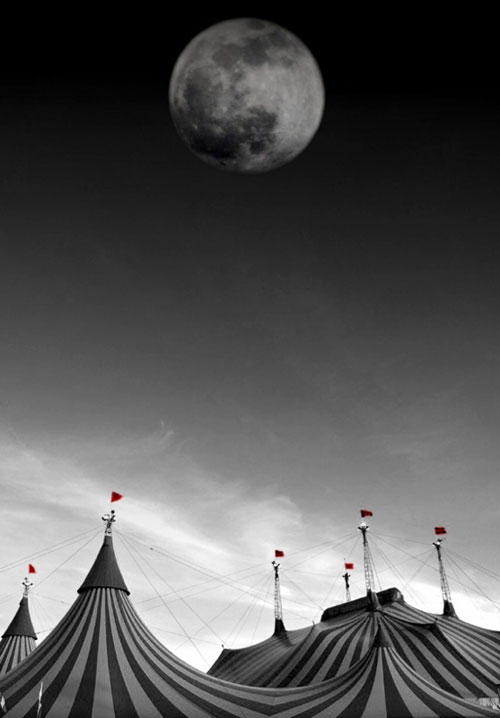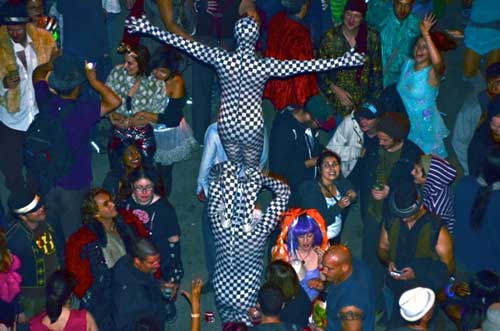|
 |
The premise is promising. A late-nineteenth century circus tours Europe and the Northeastern United States powered by mysterious means. It arrives without warning and attracts wild anticipation until the doors finally open—only at night. The tents and all costumes are black, white and shades of gray with only an occasional splash of red. Hidden among the usual circus acts featuring a contortionist, fortune teller and trapeze artists, are two orphan magicians who have grown up under the mentorship of wicked guardians who committed them to a magic duel to the death. Celia and Marco endure indentured apprenticeships, separately and in seclusion, under their sadistic adoptive fathers who have invented and locked them, without their knowledge or consent, into this competition. Celia's talents include the ability to turn articles of her own clothing into birds and Marco creates infernos that burn infinitely without any apparent need for fuel. Each grows up in grim circumstances that require monk-like devotion to studying the magic arts. They are locked up, starved, physically and emotionally abused, but given the gift of magical knowledge and all of the time in the world to practice it. About a third of the way into the book they meet, fall in love, and devote themselves to unmaking the spell that binds them.
 |
The structure of this novel, the first by Morgenstern, is chapters that jump around in time and geography, throughout the last thirty or so years of the 19th century. Chapters are divided with headings indicating the year and location of the action. Characters are introduced based on their close, tangential, or impending relationship to the circus and their actions may or may not eventually be of significance to Celia and Marco and their competition. Another series of chapters, written in second person and present tense, appear throughout the novel. These describe the actual experience of being at the circus. For example, from a chapter entitled "The Hanged Man":
In this tent, suspended high above you, there are people.
Acrobats, trapeze artists, aerialists. Illuminated by dozens of round glowing lamps hanging from the top of the tent like planets or stars.
You watch the performance from this precarious vantage point, directly below the performers with nothing in between.
There are girls in feathered costumes who spin at various heights, suspended by ribbons that they can manipulate.
Marionettes that control their own strings.
Normal chairs with legs and backs act as trapezes."
This section is typical of the language and tone of the book. Both are flat and noncommittal. It reads rather like a draft of staging directions, devoid of specificity or feeling. So, too, are the characters themselves. Flat. The reader is never given any reason to feel for the characters because the reader never knows how the characters themselves are feeling. In what could be a hot and spooky terrain filled with sexy intrigue instead is a banal and bland group of black and white tents described with words like magical, intensity and mesmerizing.
The story of sheltered near-humans being raised for the sole purposes of others' design is handled beautifully and with great though quiet emotion in Kazuo Ishiguro's "Never Let Me Go." Ultimately the story of human clones raised in a secluded prep school-like environment to serve short lives as organ donors, the characters are fully realized as people who yearn for answers to life's great questions and experiences such as love and sex and a little naughtiness, too. Ishiguro's characters change and develop through this short and compelling book. He does not employ an action-filled plot but instead uses the quiet ticking of the clock to build suspense and raise the stakes of the readers' curiosity about the characters.
 |
Sadly, Morgenstern's much-hyped novel does not draw the reader in to either the characters' inner lives or their true natures. In spite of their constant alchemic tricks they never reveal themselves or develop as people. Perhaps it is not fair to compare a freshman effort such as "The Night Circus" to a work by a master such as Ishiguro but the point is to clarify that all the magic in the world must still be performed by humans. We read fiction to learn about human nature and to discover something we hadn't considered before about human relationships. "The Night Circus" includes some fun scenes from an imaginary circus play land but it doesn't take us anywhere new in the human landscape. When Marco and Celia finally conjure a means to escape their fate and a band of second-tier characters decide to take over the circus the plot of "The Night Circus" winds to an end. Unfortunately, none of this matters because there is no reason to care.
Photos by Jon Rendell and Kelly Davidson
|


